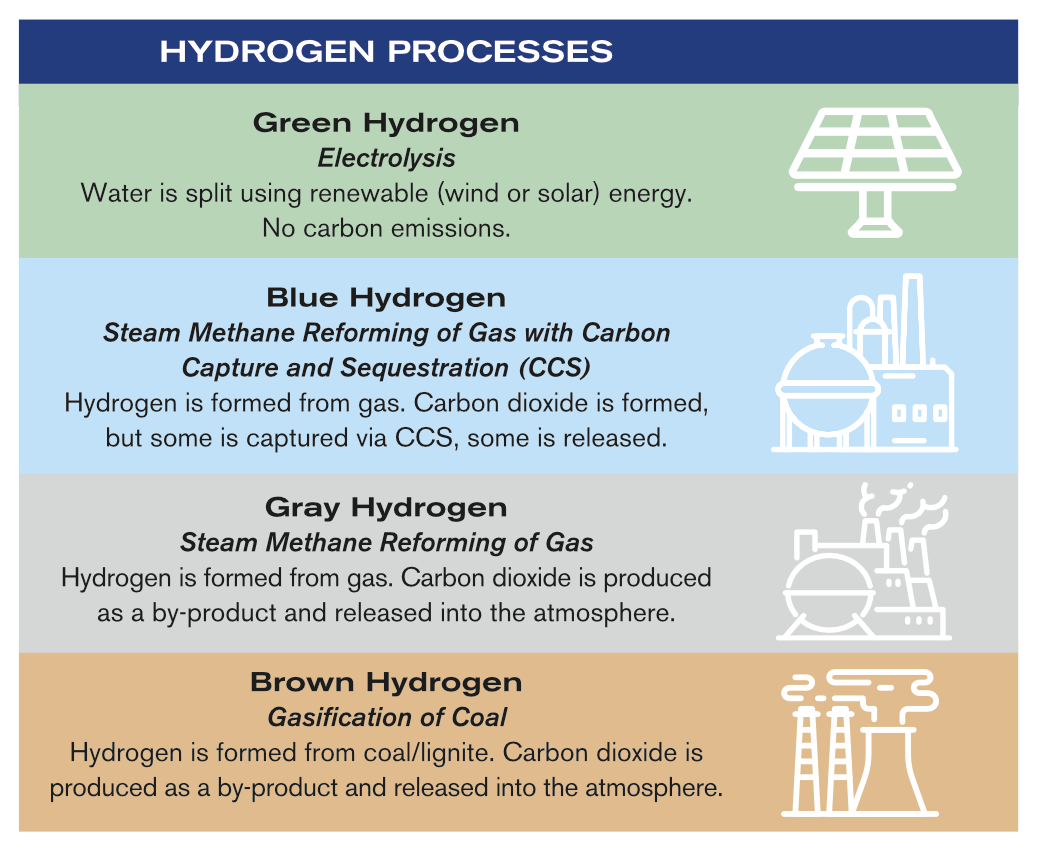All
The Dirty Underbelly of Clean Energy
by James Cunningham and Rhonda Gerson

Surprise! Hydrogen and Geothermal may not be as “clean” as advertised
It’s a familiar arc. A “new” or rediscovered form of energy is hailed as a savior to the industrial nations. “It’s cheap! It’s abundant!” In the last half-century, energy apostles added, “It’s clean!” As these hallelujahs spread into the zeitgeist, often before the first working, scalable systems are developed, a few hardy souls tentatively raise questions about just how cheap and clean the miracle energy source truly might be. These questioners are scorned, tarred as “old fashioned” and “myopic.” Should an alternate option be suggested, it is shouted down in the town halls and legislatures. After millions, billions, even trillions of dollars are spent developing and distributing the “new” energy source, science finally overtakes enthusiasm, and the “miracle” turns out to have several deep, dark, disquieting secrets. Those secrets that could have been discovered – or admitted to – much earlier, had the decision makers and influencers only heeded the questions raised by the small band of doubters.
Place any form of energy into that scenario. Coal: Cheap, abundant … uh oh! Nuclear: clean, powerful … oh, boom! Natural gas: cheap, clean, abundant … oops. Even traditional heating oil followed the same trajectory, at least until the development and acceptance of biodiesel and renewable liquid heating fuels, which might have the power to recapture some of the spotlight.
Today, the spotlight falls on electric energy, and we are still in the proselytizing phase, although some cracks are beginning to appear. Of course, electric energy is only clean if renewables are used for generation, but no one wants to concern themselves with that! (We did – read “The Question of Electrify Everything” in the June 2023 edition for more on electric energy.)
Coming in behind electricity as the answers to the world’s energy needs are hydrogen and geothermal energy. They are being supported by billions in research grants, federal incentives and tax credits, amid rising chants from well-funded public relations, marketing and lobbying teams.
But.
We’re about to be the small voice questioning the dark, dirty underbelly of these so-called clean energy sources. Again.
The Dirty Underbelly to Clean Geothermal Energy
Geothermal energy has been around for a very long time. In fact, as far back as 10,000 years ago, Indigenous groups in North America used naturally occurring hot springs to cook, bathe, and escape the freezing temperatures of winter. Since that time, civilizations throughout history, including the ancient Greeks and Romans, have used these naturally occurring geological sites and even built religious shrines around their hot springs. While these ancient civilizations may not have understood the scientific answers behind these geological wonders, their power was undeniable.
Today, a new geothermal movement is gaining steam (no pun intended) in which horizontal drilling, similar to the fracking technology developed to retrieve natural gas and oil, is being used to dig deep into the earth’s crust to access the heat trapped in the earth thousands of feet below.
So, What is Geothermal Energy?
Put simply, geothermal energy is energy created from using the heat under the earth’s surface. In the case of a natural hot spring, faults in the earth’s crust have allowed magma to rise up and heat the bedrock below the spring and heat the water on the surface. This naturally occurring heat source is known as hydrothermal energy.
When geothermal energy first became of interest as a viable energy option for large-scale production at the turn of the 20th Century, the idea was to build sites close enough to known tectonic plate boundaries where magma reservoirs were already trapped not far below the Earth’s surface. For example, Iceland sits atop two diverging tectonic plates and generates roughly 25 percent of its electricity from hydrothermal energy. While this is an incredible achievement, where does it leave the rest of the world that isn’t atop a geological crossroads?
One answer came in the form of geothermal ground-source heat pumps. Residential application of geothermal heat pumps began in the 1940s and applies a similar science to large-scale operations. In the case of a vertical-style geothermal heat pump, this requires tubing to be buried between 100 and 400 feet below the surface of the home in order to access the moderate temperature of the earth beneath. While these systems have gained popularity in recent decades, the staggering upfront cost of as much as $40,000 and the necessary land requirements still pose problems that are similar to those that have plagued the geothermal industry since its inception. In the 40s, rival energy sources like oil and coal were significantly cheaper (today it’s oil and natural gas) and drew customers away from the hefty upfront costs of geothermal systems. A similar trend happened with large-scale geothermal plants. It was easier and more profitable for industries to invest their money into other energy sources, like the booming oil industry of the 20th century. Then there is the land requirement. How do you bring geothermal heat pumps into urban areas or to single-family homes with limited property space? It’s a difficult proposition that has also affected geothermal plants. There is only so much usable land around diverging tectonic plates that geothermal plants can dig. But as they say, necessity is the mother of invention.
Introducing Enhanced Geothermal Systems
A new development that has taken the geothermal energy industry by storm is called Enhanced Geothermal Systems (EGS). EGS plants can generate geothermal electricity without the need to locate operations near tectonic shifts or magma. The concept is fairly simple: an EGS system injects water thousands of feet into the earth to permeate the rock below, and the water is then pumped back up at upwards of 375° Fahrenheit and used to power steam turbines. This removes the limitation of drilling only in geographically favorable locations such as Iceland or the Northern California Geysers and can create underground reservoirs that provide consistent energy or can be called upon as needed.
Without a doubt, the company that has spearheaded this movement is the Frontier Observatory for Research in Geothermal Energy (FORGE). This Department of Energy-sponsored company has been tasked with developing, testing, and accelerating breakthroughs in EGS technologies in exchange for a $220 million grant from the US government. Their drill site in Beaver County, Utah, is trying to establish itself as the first geothermal reservoir that doesn’t naturally exist. In utilizing the same drilling technology long since established by the natural gas and oil industries, FORGE is putting large-scale EGS practices to the test.
But if this sounds a lot like fracking to you – that’s because it is.
The Problems with Fracking Persist
New developments in EGS plants stoke the flames of a fire that has never been put out. Fracking. The process in which liquids are injected into the earth at high pressure to break open existing fissures and extract natural gas or oil. In this case, the fracking is used to make the hot, subterranean rock permeable so the injected water can flow freely and heat up adequately. But what does this do to the nearby drinking water?
The natural gas industry has been settling claims and paying fines related to contaminated water from fracking for years. Longtime Oil & Energy readers will recall reports of homeowners who had their drinking water burst into flames due to methane leaks from nearby natural gas wells. Still, the fracking technology used at EGS sites is being lauded as a major achievement for the industry.
And what will happen when they build an EGS site over an unknown fault line? For years, the natural gas industry has been trying to distance itself from the issue of fracking-related earthquakes. In Gaoshan, China, a 2019 earthquake is said to be the first fracking-caused earthquake to take human life. While that area is prone to such geological events, research has shown that the drilling at a nearby natural gas site was almost certainly the cause of the 2019 earthquake.
There’s no doubt that science has come a long way, but when you’re digging into the earth at upwards of 10,000 feet to tap into the rock beneath, it is impossible to account for every variable. The issue is, what will the ramifications be for an oversight of such magnitude? While achievements in renewable energy should certainly be recognized, the reality of fracking-related issues cannot be overlooked in light of the shiny, new renewable resource on the block.
There’s no denying the potential power we can wield from geothermal energy, and the recent advances have garnered much acclaim and attention. The geothermal startup, Fervo, partnered with Google in 2021 to create a geothermal site in Nevada to power their servers with 24/7 renewable energy. Whether geothermal energy is the answer to achieving a net-zero future still remains to be seen, but the environmental fallout brought on by fracking is known, and those same issues will not be far behind.
The Dirty Underbelly to Clean Hydrogen Energy
Hydrogen is one of the most abundant elements on Earth. It is in almost everything. Water (H20), Methane/Natural Gas (CH4), Propane (E3H8), Ammonia (NH3). It does not exist freely on its own in nature but is an efficient energy carrier when separated from other sources.
In a fuel cell, hydrogen produces heat or electricity, with only water vapor as a by-product. Hydrogen gas can be stored – as long as the pressure is high enough and temperatures are low enough. Hydrogen is generally touted as the clean energy answer for sectors that are difficult to electrify, such as long-haul trucking and transportation, air travel, maritime shipping and industrial processes like steel production.
As with the buzz behind electricity’s so-called “zero carbon” properties, hydrogen does not produce carbon at the point of use. Hailing hydrogen as a net-zero fuel, however, ignores the NOx, methane and ozone emissions from the production and combustion processes.

Green Hydrogen – An Answer or Illusion?
Green hydrogen is created when the hydrogen molecules in water are separated from the oxygen by electrolysis powered by wind or solar energy. No fossil fuels are used, there is no combustion during the process, and there are no emissions.
Generating 1kg of hydrogen through electrolysis requires about 9kg of water. According to the Sierra Club, supplying hydrogen for one 288-magawatt power plant would require the equivalent of an Olympic-sized swimming pool worth of water every 12 hours, and additional water for cooling. That works out to 15-to-20kg of water for every kilogram of hydrogen. This vast water requirement is still less than the amount of water used in fracking and other fossil fuel extraction and processing operations.
Steam methane reforming (SMR) of gas without any carbon capture and sequestration (CCS) accounts for nearly all commercially produced hydrogen in the United States. In SMR, high-temperature steam under high pressure reacts with methane in the presence of a catalyst to produce hydrogen, carbon monoxide and a “relatively small amount of carbon dioxide,” according to the Energy Information Administration.

Only about 0.02 percent of current hydrogen production is green, and more than 99 percent of the U.S. annual supply, or 10 million metric tons, comes from fossil fuels and SMR. As the “explainers” at MIT explain, “for the climate, not all hydrogen is created equal. Because pure hydrogen is so rare on Earth, the hydrogen we use must be produced from other compounds. However, hydrogen production can have a large environmental impact depending on how it is produced. Today, close to 95 percent of hydrogen production is from fossil fuels like natural gas and coal. As a result, we emit 830 million tonnes of CO2 each year to produce 74 million tonnes of hydrogen.”
Green hydrogen is formed via electrolysis, a process that splits hydrogen from water using an electric current. Commercially, it is also referred to as power-to-gas, where the power is electricity, and the gas is hydrogen. Electrolysis itself may not produce any by-products or emissions other than hydrogen and oxygen, but if the electricity comes from the fossil fuel powered grid, rather than wind or solar, the hydrogen cannot be classified as green.
In any process, there is an initial resource (water, gas, coal) that is burned, steamed or electrolyzed to produce the hydrogen, which then needs to be processed through a fuel cell to produce energy. In and of itself, regardless of how much hydrogen is produced, the process is inefficient. The Sierra Club estimates that using renewables to produce hydrogen is 20 to 40 percent less efficient than using the renewable directly, when direct use is feasible.
But wait, there’s a map!
In June, the U.S. Department of Energy (DOE) released the U.S. National Clean Hydrogen Strategy and Roadmap. The document states, “Realizing these opportunities for clean hydrogen will require lower cost of production, the buildout of midstream infrastructure, and increased hydrogen demand in specific sectors where there are fewer cost-competitive or technically feasible alternatives for decarbonization,” and prioritizes three key strategies to ensure that clean hydrogen is developed and adopted as an effective decarbonization tool:
- Target strategic, high-impact uses for clean hydrogen
- Reduce the cost of clean hydrogen
- Focus on regional networks
The “Strategy and Roadmap” is one step in the DOE Hydrogen Shot to reach “1 1 1” = $1 per 1 kilogram of clean hydrogen in 1 decade. This is part of a circular demand/growth strategy: the country will need to produce clean energy with renewable resources to produce clean hydrogen via electrolysis. The report estimates that if 90 percent of hydrogen is produced via electrolysis in 2030, this would require up to 200 GW of new renewables or the use of 50-70 GW of nuclear power.

The Bipartisan Infrastructure Act and the Inflation Reduction Act included billions for research, development, infrastructure, networks and standards for clean hydrogen. The DOE practically gushes about the benefits:
“Clean hydrogen can be produced from diverse domestic resources and used across sectors. Production can be centralized or decentralized, grid-connected or off-grid, offering scalability, versatility, and regionality. Clean hydrogen provides more options across sectors and can complement today’s conventional grid and natural gas infrastructure. Rather than only ‘electrons to electrons’ pathways such as the electric grid to batteries, hydrogen can be stored and used where electrification may be challenging.”
There is that pesky issue with emissions, however. The Roadmap continues: “Initial deployments using clean hydrogen are expected to leverage regional energy resources and target industries that currently rely on conventional natural gas to hydrogen technologies (without CCS).” EPA proposes that hydrogen co-firing with natural gas is the best system of emissions reduction for certain subcategories of fossil fuel powered plants, and it would be among compliance options for CO2 emission limits on fossil fuel-fired power plants under Section 111 of the Clean Air Act. “While these industries can rapidly generate scale and create near-term impact in terms of emissions reductions, concerted efforts must be made to solicit and address community concerns around NOx emissions, safety and leakage detection. Increased transparency must include acknowledging these potential risks while juxtaposing them with the extensive safety training, monitoring and detection technologies that have been developed,” the Roadmap continues.
There are also other challenges, such as cost, infrastructure, public awareness, competing technologies, and end-users. As with most “Roadmaps” there are a lot of potential detours. The Clean Hydrogen Strategies and Roadmap anticipates that the next several years will be spent “creating pathways,” “identifying and prioritizing barriers,” “demonstrating replicable, scalable production,” “engaging regulators and stakeholders,” “laying groundwork” and other vaguely worded tasks. This all comes to fruition, somewhere between 2030 – 2050, where hydrogen is, if all goes to according to plan, delivered at scale, at $1/kg and producing good paying jobs and environmental justice for all.
Pipeline or Pipe Dream
One would think the environmentalists would be “team hydrogen,” and they are, albeit cautiously. The Environmental Defense Fund says that “under the right circumstances, hydrogen could indeed be part of a clean energy transition. But done wrong, it could be worse for the near-term climate than the fossil fuels it would replace.” EDF continues, stating, “traditional metrics systematically ignore the near-term impact of hydrogen and other short-lived climate-forcing agents by expressing the warming effects from a one-time pulse of emissions over a 100-year timeframe (GWP-100), masking a much bigger, more immediate influence. Applying the combined atmospheric effects over a shorter, more relevant timeframe, we estimate the five-year warming power from a pulse of hydrogen relative to CO2 is 20 times greater than current calculations show using the standard 100-year approach. And when we look at the relative warming impact from continuous instead of pulse emissions — which are more representative of the real world — hydrogen is 100X more potent than CO2 emissions over a 10-year period.”
The Sierra Club fears that “many hydrogen projects will only lock us in to continued fossil fuel use and additional investments in fossil fuel infrastructure,” and so gives conditional support for the use of green hydrogen only. They further explain that a blend of hydrogen and methane at a power plant will lower carbon emissions, but “hydrogen has a lower energy density than gas, meaning it takes a larger volume of blended hydrogen and methane to provide the same energy input as an equal volume of gas. Because of this, a blend of 30 percent hydrogen and 70 percent gas by volume only results in a 13-percent decrease in carbon emissions at end-use.”
When hydrogen is combusted, it does not produce carbon emissions, but it does emit nitrogen oxides (NOx), which can be many times worse than those released by methane combustion. NOx can cause serious health effects, including asthma and increased chance of respiratory infections; NOx is also a precursor to particulate matter and ozone, which harm the respiratory system.
Furthermore, these organizations warn, the existing gas steel pipelines could not be used to transport hydrogen, as they are susceptible to “hydrogen embrittlement.” Due to the lower density properties of hydrogen gas, it needs to be stored in high-pressure tanks or as a liquid. Liquid storage requires maintaining cryogenic temperatures. The Sierra Club suggests that replacing gas with hydrogen in the global economy would require as much as four times the current storage infrastructure and an investment of $637 billion by 2050, just to provide the same level of energy as the world would have with gas.
Red Flag Warnings
If this all sounds familiar, it should. Fracking and cheap natural gas were going to save the country … until people realized the dangers of fracking and the near-term global warming potential of methane. A modified version of fracking is coming back to access the heat from molten rocks deep underneath the Earth’s crust. But fracking itself is no cleaner or safer than it was a decade ago.
Green hydrogen may have zero carbon emissions, but true green carbon is rarely produced. Hydrogen has severe short-term global warming potential … but since it is not-carbon, no one is paying attention. Yet.
Once again, the renewable liquid fuels industry is sitting on the sidelines, waiting, watching and wondering. How long will it be until the global warming potential of not-carbon greenhouse gases is considered? It took decades for methane to be acknowledged as an immediate threat that needed to be addressed. Hydrogen and geothermal/hydrothermal power are moving into cultural focus as “cleaner” power generators for electric generation and end-use, but they also deliver near-term risks. If this summer’s unnatural heat waves are any clue, we don’t have decades to spare.
Related Posts
 Care and Treatment of Biodiesel Blends
Care and Treatment of Biodiesel Blends
Posted on December 18, 2025
 EIA Winter Fuels Outlook
EIA Winter Fuels Outlook
Posted on December 18, 2025
 How to Set Your Business Apart with Renewable Propane
How to Set Your Business Apart with Renewable Propane
Posted on October 16, 2025
 EIA Report: Biodiesel and Renewable Diesel Imports Fall Sharply
EIA Report: Biodiesel and Renewable Diesel Imports Fall Sharply
Posted on October 16, 2025
Enter your email to receive important news and article updates.
